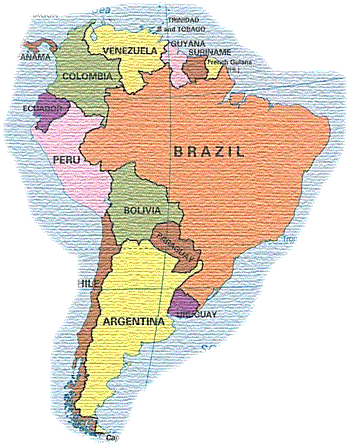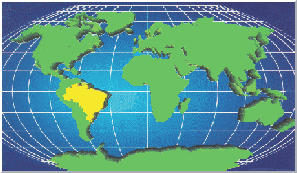

Brazil During the Proterozoic
by Meg Ansara

Introduction: A General Overview of the Geology of Brazil


Brazil During the Proterozoic

Introduction: A General Overview of the Geology of Brazil
The geology of Brazil coincides almost entirely with the South American platform, the crystalline core of the South American Continent. More than half of the country's total territory consists of Precambrian rock units, making the Proterozoic an interesting time to study in the context of Brazil (Fairchild et al. 1996). The Geological Survey of Brazil is currently carrying out much of this research. The basement of Brazil consists of ancient metamorphic and igneous rocks that have not undergone tectonic regeneration since the beginning of the Phanerozoic. A layer of sedimentary rocks with almost horizontal bedding covers the cystalline basement. Some of these sedimentary rocks are as old as the early Precambrian period while others only date to between 500-1000 Ma. The country's cratonic areas consolidated more than 1700 Ma with fold belts that formed during 500-1700 Ma. The sedimentary cover that accumulated during the Early Silurian period collected in three large intercratonic basins until the platform became completely stabilized. The break up of the ancient Gondwana continent during the late Jurrassic to Early Cretaceous periods caused tectonic reactivation that produced an additional intercratonic basin along the Atlantic continental margin (De Almeida 1981).
Geologists have distinguished ten different structural provinces within the country of Brazil. Each province is a terrane, a large area with features of stratigraphic, tectonic, metamorphic, and magmatic evolution that differ from the provinces around it (De Almeida 1981). The subject of this research project is the SAO FRANCISCO PROVINCE, a cratonic area with an Archean granitic basement as well as younger sedimentary units. The province is located in the South-Central part of Brazil in the state currently known as Minas Gerais
Areas of Interest in the Sao Francisco Province
General Overview
Diamonds
Banded Iron Formations
Microfossils
Bibliography

General Overview:
The geology of one area in the Sao Francisco Province, known as the Pre-Minas Supergroup, demonstrates the many tectonic changes experienced by the province through the evolution of the Earth. The supergroup consists mostly of an Archean basement of older granitic units as well as younger schist units in the form of greenstone belts. The unconformities present in the group are a result of transgressive and regressive sea level changes probably caused by periods of glaciation. Conglomerates and sands are evidence of high energy shore line environments that would accompany such changes. There are also many banded iron formations in the area. The Espinhaco Orogeny from ~2000-1300 Ma set the present day tectonic picture with folding and faulting caused by horizontal pressure against the western edge of the Sao Francisco Craton. Volcanic activity also occured in the last stage of the orogeny. Regional dynamothermal metamorphism around ~1400-1100 Ma produced a lot of mineral changes within the rocks because of the high pressures of 2-4 kbar and temperatures of 430-500 degrees celsius. Finally, the Brazilian cycle from ~700 to 450 Ma resulted in an East to West compression and regional temperature rise that produced large scale recystallization of quartz and mica growth that can still be seen in samples today.
Diamonds:
Until the discovery of the massive kimberlite pipes in South Africa in 1870, Brazil was the world's leading producer of diamonds. Diamonds, some of them particularly large, have been mined from brazil for over two hundred years. Some of the most well known stones include the President Vargas (726.60 kt), the Darcy Vargas (460.0kt) and the Coromandel IV (400.65kt) all of which have been found in the Coramandel region in the state of Minas Gerais. The diamonds have been primarily found in the sedimentary layers from the lower Proterozoic to the Quartenary periods (Tompkins 1989).
Despite the abundance of stones found, the exact origin of diamonds in Brazil has been hotly debated. In the article "Diamonds in Brazil and a Proposed Model for the Origin and Distribution of Diamonds in the Coramandel Region," Linda Tompkins and Guilherme Gonzaga propose a new model for diamond distribution correlated with three principal glaciations. According to the model, a Precambrian diamondiferous kimberlite event occured in Brazil which intruded principally on the Sao Francisco Craton. The diamonds produced by this event were then transported through fluvial processes to the margins of the craton where they were then reconcentrated in a coastal storm beach environment. These diamond deposits were then incorporated into glacial ice sheets of the Jequitai Glaciation in the lower Proterozoic and the Sante Fe Glaciations in the Cambrian and Carboniferous periods. By suspending the stones in vast sheets of ice, glaciers have the capacity of transporting large diamonds over extreme distances thus creating the wide distribution of diamonds all over Brazil that are being mined today (Tompkins 1989).
Banded Iron Formations:
In addition to having diamonds and greenstone belts, the Sao Francisco Province also has many banded iron formations. Though the majority of banded iron formations are believed to be deposited in deep marine passive margins, some banded iron formations are deposited at active margins during the process of subduction. The banded iron formations in Brazil were deposited in such situations during the late Archean and ealy Proterozoic periods when the hydrosphere and atmosphere of Earth were both anoxic, lacking in free oxygen and without an ozone layer (Castro 1994).
The subduction model of banded iron deposition begins with the subducting piece of oceanic lithosphere becoming cut by faults and fractures as a result of the many forces acting upon it. The faults grant access to sea water to leach minerals from the subducting crust, creating hydrothermal convection systems. In these systems, ferrous oxide, silica, and other compounds are dissolved from the walls of the fractures and carried to the sea floor where they are deposited. The lack of free oxygenin the atmosphere makes the ferrous iron soluble in water. Consequently, large amounts of banded iron formations were deposited consisting of FeO-SiO2 rich solutions. This style of banded iron deposition continued regularly in the Minas Gerais state of Brazil until the oxygenation of the oceans and atmosphere (Castro 1994).
Microfossils:
Twenty-two Precambrian microfossiliferous localities have recently been identified from the Sao Francisco Province and the associated Brasilia fold belt. The fossils were found from drill core samples of Meso and Neoproterozoic cherts, carbonates, and siliclastics of the ~1170-950 Ma Paranoa Group and the ~950-700 Ma Sao Francisco Supergroup. Nearly 30 different genera are represented by the Proterozoic fossils from the area. The majority of the fossils were of cyanobacteria and subsidiary acritarchs primarily preserved within carbonaceous black chert in high-relief stromatolites. Sub-surface pelites and outcrop samples of limestones also yielded small numbers of fossils (Fairchild et al. 1996).
The fossils represent a wide variety of envrionments existing during the Proterozoic period including near-shore lagoonal, supratidal, intertidal, subtidal, and offshore marine settings. Supratidal and intertidal fine-grained dolomites and planar microbialites, inter-tidal to shallow subtidal stromatolites and ooids, and relatively shallow-water pelitic sediments containing preserved cyanobacterial mat communities all found in the area provide evidence for near-shore carbonate and siliciclastic environments existing during Proterozoic times. Distal pelites containing assemblages of many spheroidal acritarchs provide evidence for deeper sub-tidal environments (Fairchild et al. 1996).
More numbers of microfossils and a greater diversity among the fossils found were discovered in the older unit, the Paranoa block, than in the younger unit. However, one microfossil from the Sao Francisco Supergroup is the best known preserved microfossil in South America. This evidence suggests that cyanobacteria and acritarchs were more abundant during the earlier part of the Proterozoic period (Faichild et al. 1996).
Bibliography: